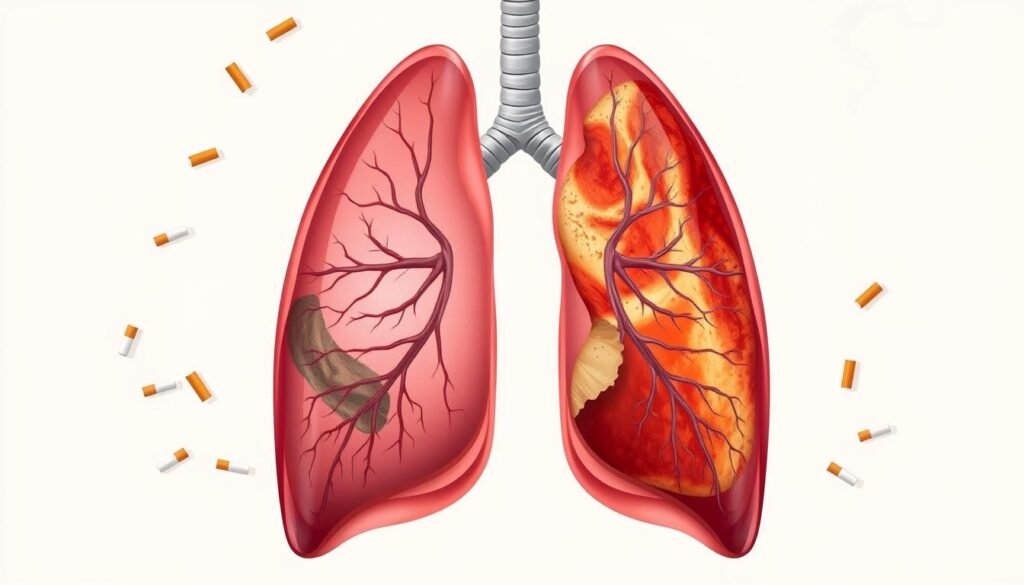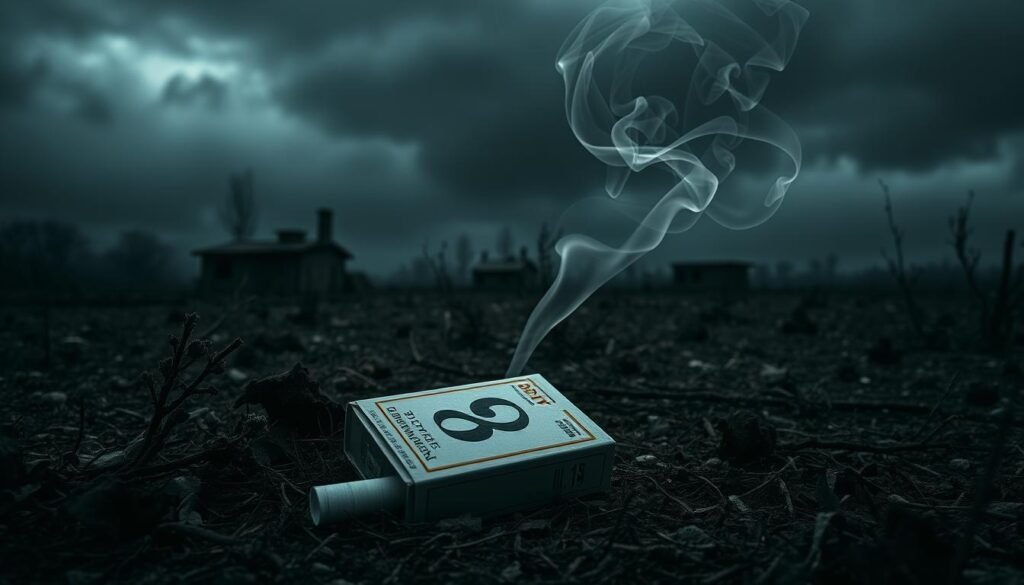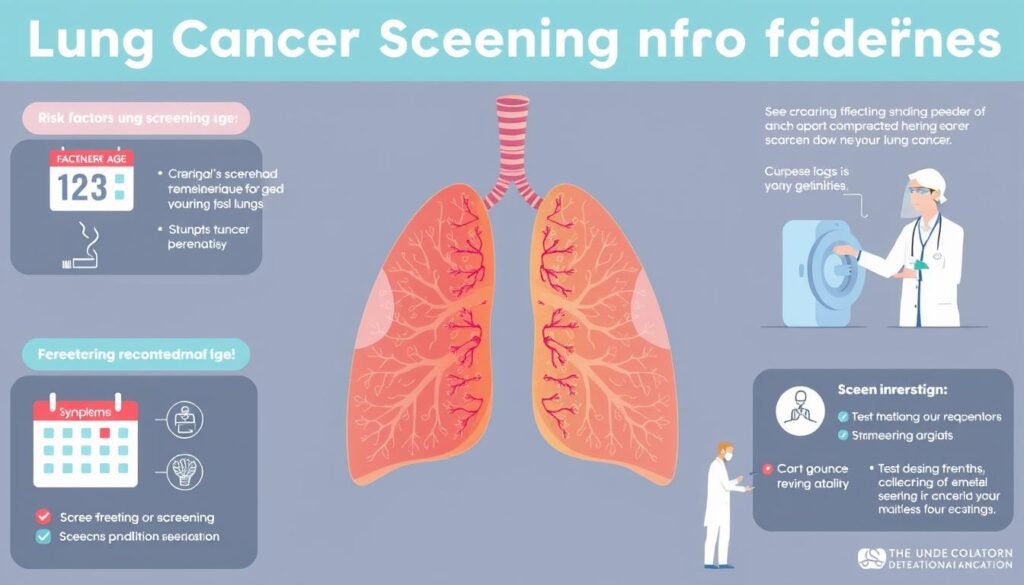Did you know that around 85% of lung cancer cases come from smoking? This shows how much smoking affects lung cancer risk. If someone has smoked a pack a day for 15 years, they’re at risk. It’s important to know this for lung cancer awareness and to prevent it. We will look into the danger of pack years, when to get screened for lung cancer, and how stopping smoking helps.
Key Takeaways
- Cigarette smoking is the primary risk factor for lung cancer.
- 15 pack year history signifies a heightened vulnerability to lung cancer.
- Quitting smoking significantly reduces cancer risk but does not eliminate it completely.
- Lung cancer screenings can reduce death rates by over 20%.
- Screenings are recommended for individuals aged 50 to 80, especially those with a significant smoking history.
Understanding Pack Years and Lung Cancer Risk
Lung cancer risk is linked to pack years, a key health measure from smoking. Pack years blend how long and how much someone has smoked. This gives a full view of a smoker’s history.
What is a Pack Year?
The pack year definition is found by multiplying smoked packs per day by the smoking years. For example, smoking one pack daily for 20 years equals 20 pack years. Smoking half a pack daily for 30 years equals 15 pack years. This calculation helps doctors see the risk of lung cancer and other illnesses.
The Relationship Between Smoking Duration and Intensity
How long and how much you smoke affects lung cancer risk. The number of cigarettes smoked daily is watched closely. But, how long someone has been smoking is just as important. Longer smoking can mean higher risk, even with fewer cigarettes daily.
Health is impacted in many ways by smoking. Both smoking length and amount matter for lung cancer risk. Scientists say we should look at both to understand a smoker’s health risks better. This comes from findings in medical journals.
15 Pack Year Lung Cancer Risk
Understanding which people are at high risk is crucial for lung cancer detection. The 15 pack year criteria help find those at high risk because of their smoking history. These guidelines also consider an individual’s age for screening. Sadly, this can miss some people who need checks early.
Who is Considered High Risk?
People with a smoking history of 15 pack years or more are seen as high risk. This group includes both people who smoke now and those who have stopped. There’s a big gap in who can get screened, especially among Black patients. Late detection in this group is too common. Making the rules for who gets screened better could help fix this gap.
How Pack Years Correlate with Lung Cancer Incidence
The more pack years someone has, the more likely they are to get lung cancer. This is true even for people who have quit smoking. They still face a high risk long after they’ve stopped. Even those meeting the 15 pack year rule might be at big risk, which affects their chance of survival based on their smoking past.

Smoking History and Its Impact on Health
It’s crucial to understand how smoking affects health. Long-term smoking increases the risk of serious health problems, like lung cancer. Studies show the longer someone smokes, the greater their risk of getting cancer. Preventing smoking and raising awareness can help reduce these harmful effects.
The Dangers of Long-term Smoking
Cigarette smoking causes about one in three cancer deaths in the U.S. Smokers are about 25 times more likely to get lung cancer than non-smokers. Secondhand smoke also causes over 7,300 lung cancer deaths in the U.S. each year. Even after quitting, some cancer risks remain high, showing the lasting dangers of smoking.
Effects of Smoking on Lung Cancer Development
There’s a strong link between smoking and lung cancer. A staggering 87% of lung cancer deaths are because of smoking. Heavy smokers face a much bigger risk. For example, current smokers have lung cancer rates nearly 7.5 times higher than those who never smoked. Even people who’ve quit smoking still have a higher chance of lung cancer.
Anyone who has smoked a lot over the years should get checked for lung cancer every year. This shows how vital early detection and stopping smoking are in lowering these risks.

Lung Cancer Screening: Importance and Guidelines
Lung cancer screening is key in finding the disease early. This improves how well treatment works. People at high risk should follow lung cancer screening rules closely. The American Cancer Society says people 50 to 80 with a 20 pack-year smoking history should get screened every year.
Current Lung Cancer Screening Recommendations
It’s important to spot those who might have lung cancer early. The U.S. Preventive Services Task Force says CT scans can help. These scans use a little bit of radiation to take clear lung pictures. Sadly, not many who need it get screened.
Low-Dose CT Scanning Explained
Low-dose CT scans are a game-changer for detecting lung cancer early. They give high-quality images with less radiation. This method has helped in catching cancers early. That means better chances of handling the disease, especially for those with a heavy smoking past. This includes even those who’ve stopped smoking recently.

| Age Group | Smoking History | Screening Frequency |
|---|---|---|
| 50 to 80 years | 20 pack-years or more | Annual |
| Individuals previously smoked | Quit more than 15 years ago | Consideration for screening |
| 81 years and older | History of smoking or health issues | Discontinue screening |
Detecting Lung Cancer Early: Symptoms and Signs
Finding lung cancer early is key to better survival rates. Many people don’t show early symptoms. Knowing these early signs is crucial for quick action and better results.
Those at high risk, like smokers or past smokers, should get routine checks. It’s vital for catching lung cancer early.
Common Symptoms of Lung Cancer
It’s important to watch for early signs of lung cancer. Catching these early can help find lung cancer sooner. Look out for these common symptoms:
- Persistent cough that lasts more than a few weeks
- Chest pain that gets worse with deep breaths or coughing
- Unexplained weight loss without diet or exercise changes
- Coughing up blood or rust-colored spit
- Shortness of breath or trouble breathing
Catching Lung Cancer in Its Early Stages
Early detection greatly improves chances of beating lung cancer. Regular checks, especially LDCT scans, are crucial for at-risk groups. The American Cancer Society suggests yearly screening for 50 to 80-year-olds who’ve smoked a lot over the years.
Knowing the early signs and risks of lung cancer leads to early action.
| Symptom | Description |
|---|---|
| Persistent cough | It drags on for weeks and may get worse as time goes on. |
| Chest pain | Pain that rises with a deep breath or cough. |
| Unexplained weight loss | Weight drops without trying, with no change in eating or activity. |
| Coughing up blood | Seeing blood in spit is serious and should be checked out. |
| Shortness of breath | Struggling to breathe, even after slight effort. |
If you have these symptoms, see a doctor fast. Being alert and proactive about lung cancer can save your life.
Barriers to Lung Cancer Screening
Lung cancer screening is key for early detection, but faces big hurdles. Issues with awareness and access are at the forefront. For instance, studies show that over 80% of those eligible don’t know about screening options. This lack of knowledge is why screening rates are so low, hovering between 5% and 19% for those eligible.
There’s also a stark difference in screening eligibility between different racial groups. Only 58% of Black people and 74% of white people meet current guidelines. But if the guideline were just a 20-year smoking history, over 80% of both Black and white people with lung cancer would be eligible. This suggests we need better outreach to cater to the unique needs of all communities.
Awareness and Access Issues
Many people don’t know enough about lung cancer screening. It’s not as common as screenings for breast or colon cancer, which see rates of 60% to 80%. Lung cancer screenings are much less common, which is problematic.
Challenges Faced by Specific Demographics
Diverse groups face more obstacles that make lung cancer screening harder. Relying just on smoking history and age misses other key risk factors. This often leaves many at risk people undiagnosed and untreated until it’s too late. It’s vital we overcome these barriers to make health equity in lung cancer screening a reality. For more insight into these issues, check out additional information on lung cancer screening barriers here.
Tobacco Cessation: Taking Action Against Lung Cancer
Quitting smoking is a powerful step towards better health and lowering lung cancer risk. The benefits of quitting smoking reach beyond lung cancer reduction, improving overall well-being. Those who quit smoking see a huge drop in the chance of smoking-related diseases. This makes quitting vital for health improvement.
The Benefits of Quitting Smoking
About 85% of lung cancers stem from smoking. This fact highlights why it’s crucial to stop smoking. If you quit smoking, even after a lung cancer diagnosis, you lower the chance of developing another lung cancer. Stopping smoking before turning 40 reduces long-term health risks greatly.
Quitting smoking has many benefits:
- Enhanced lung function
- Lower risk of heart disease
- Improved quality of life
- Financial savings
Resources and Support for Tobacco Cessation
There are many resources available to help people quit smoking. Support networks, quitlines, counseling, and community groups offer crucial support. The National Cancer Institute provides tailored resources for effective quitting strategies. Using these tools could save over 12,000 lives annually through lung cancer prevention and screening.
Promoting a healthy lifestyle after quitting is important. It emphasizes being active, eating well, and drinking alcohol in moderation. Living smoke-free keeps reducing lung cancer risk, showing the path to a healthier life is always within reach.
| Benefit of Quitting | Impact on Health |
|---|---|
| Reduced Cancer Risk | Lower risk of lung and other cancers |
| Heart Health | Lower risk of heart disease and stroke |
| Lung Function | Improved lung capacity and breathing |
| Life Expectancy | Increased longevity and overall health |
Related Health Conditions: Emphysema and COPD
Emphysema and COPD are big worries for those who smoke or have smoked a lot in the past. This smoking habit is a key cause of these serious health issues. It greatly harms lung function and life quality. Knowing how smoking links to these diseases is vital for better patient care.
Understanding the Connection Between Smoking and Lung Disease
It’s well-known that smoking and lung diseases like emphysema and COPD are connected. Studies show that having emphysema increases the risk of lung cancer. For instance, a CT scan showing 5% emphysema can make Caucasians 3.8 times more likely to get lung cancer. People under 65 with emphysema are at an even higher risk, with a 4.64 chance of getting lung cancer.
Also, heavy smokers who’ve smoked a lot over the years and have emphysema have a 4.46 risk of lung cancer. Emphysema often happens along with COPD, affecting about 10% of people. This highlights how important it is to know about these risks early on.
Management and Treatment Options for Patients
Treating emphysema and COPD involves many steps. These treatments aim to meet each patient’s needs. Options may include:
- Medications like bronchodilators and corticosteroids
- Lifestyle changes, like stopping smoking and starting exercise programs
- Pulmonary rehabilitation to help improve lung function and overall health
- Regular check-ups and screenings to watch for the disease getting worse
By actively managing emphysema and COPD, people can live better lives. The right help lets patients deal with the problems smoking-related lung diseases cause. Early finding and sticking to treatment plans are key.
| Condition | Increased Cancer Risk (OR) | Age Group | Pack-Years |
|---|---|---|---|
| Emphysema | 3.8 | Caucasians | N/A |
| Emphysema | 4.64 | N/A | |
| Heavy Smokers with Emphysema | 4.46 | All ages | ≥40 pack-years |
| Small-cell Lung Cancer Patients with Emphysema | 5.62 | All ages | N/A |
Conclusion
The risk of lung cancer with a history of 15 pack-years of smoking is serious. Everyone needs to know about lung cancer. People who smoke now or used to smoke, especially over 20 pack-years, should get regular check-ups. This is key for catching the disease early. In the U.S., 10 million people could benefit from getting screened early. This could lead to better health outcomes for many.
Quitting smoking can greatly lower the risk of lung cancer, by up to 75% in 10 to 15 years. It’s important to spread the word about how to stop smoking. This can help lower the number of lung cancer cases. By knowing more about smoking and screening benefits, we can prevent the disease. This leads to healthier lives ahead.
In summary, knowing the dangers of smoking, pushing for early screenings, and sharing info on stopping smoking can reduce lung cancer’s impact. As more people understand this, they need to act. They must know their risk and take steps to prevent the disease or catch it early. This effort can save lives.